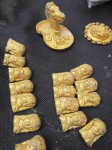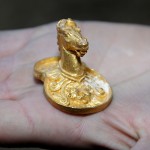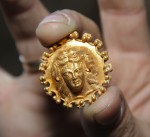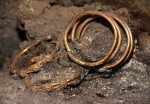 Archaeologists excavating a tomb in a Thracian burial complex about 250 miles northeast of Sofia, Bulgaria have unearthed a collection of beautifully worked gold artifacts. The pieces date to the end of the 4th or the beginning of the 3rd century B.C. and include four bracelets decorated with snake heads, a tiara or necklace decorated with lions and fantasy animals, 44 small gold busts of women which could have been horse trappings or clothing accessories, 100 gold buttons, a large gold ring or brooch with a female face in high relief and an incredibly life-like miniature golden horse head that once decorated the end of a bit.
Archaeologists excavating a tomb in a Thracian burial complex about 250 miles northeast of Sofia, Bulgaria have unearthed a collection of beautifully worked gold artifacts. The pieces date to the end of the 4th or the beginning of the 3rd century B.C. and include four bracelets decorated with snake heads, a tiara or necklace decorated with lions and fantasy animals, 44 small gold busts of women which could have been horse trappings or clothing accessories, 100 gold buttons, a large gold ring or brooch with a female face in high relief and an incredibly life-like miniature golden horse head that once decorated the end of a bit.
 The high quality of workmanship indicates that these were adornments of the elite, and indeed the tomb in which this treasure was discovered is the largest out of the 150 tombs in the complex near the village of Sveshtari. The complex was built by the Getae people, a Thracian tribe of warrior horsemen who inhabited the Lower Danube region in areas now part of Romania and Bulgaria. They initially used their famed cavalry skills in the service of other Thracian kingdoms, but by the late 4th century had splintered into principalities of their own.
The high quality of workmanship indicates that these were adornments of the elite, and indeed the tomb in which this treasure was discovered is the largest out of the 150 tombs in the complex near the village of Sveshtari. The complex was built by the Getae people, a Thracian tribe of warrior horsemen who inhabited the Lower Danube region in areas now part of Romania and Bulgaria. They initially used their famed cavalry skills in the service of other Thracian kingdoms, but by the late 4th century had splintered into principalities of their own.
 The Getic kings had access to the gold deposits at the mouth of the Danube, one of the largest sources of gold in ancient Europe. As early as the 7th century B.C., the Getae traded with the Greek colonies on the western shores of the Black Sea, and later with the Macedonians to the southwest of them and the Scythians north of the Danube. The style of the gold work discovered in the tomb reflects this variety of cultural influences from the peak of Getic rule in the area.
The Getic kings had access to the gold deposits at the mouth of the Danube, one of the largest sources of gold in ancient Europe. As early as the 7th century B.C., the Getae traded with the Greek colonies on the western shores of the Black Sea, and later with the Macedonians to the southwest of them and the Scythians north of the Danube. The style of the gold work discovered in the tomb reflects this variety of cultural influences from the peak of Getic rule in the area.
 Diana Gergova, head of the excavation team, thinks the size of the tomb and the richness of its contents suggest a connection to one of the earliest Getic princes.
Diana Gergova, head of the excavation team, thinks the size of the tomb and the richness of its contents suggest a connection to one of the earliest Getic princes.
“From what we see up to now, the tomb may be linked with the first known Getic ruler Cothelas,” said Gergova, a renowned researcher of Thracian culture with the Sofia-based National Archaeology Institute.
 Cothelas is known for having struck a treaty with King Philip II of Macedon in 341 B.C. while the latter was fighting the Balkan peoples to the west of Thrace. He became Philip’s vassal and sealed the deal by marrying his daughter Meda to the Macedonian king. She was his fifth wife, coming six years after his marriage to his fourth wife, Olympias, mother of Alexander the Great. When Philip died in 336 B.C., Meda committed ritual suicide to accompany him to the afterlife, a gesture that was not Greek or Macedonian practice and thus secured her a place in Philip’s tomb at Vergina.
Cothelas is known for having struck a treaty with King Philip II of Macedon in 341 B.C. while the latter was fighting the Balkan peoples to the west of Thrace. He became Philip’s vassal and sealed the deal by marrying his daughter Meda to the Macedonian king. She was his fifth wife, coming six years after his marriage to his fourth wife, Olympias, mother of Alexander the Great. When Philip died in 336 B.C., Meda committed ritual suicide to accompany him to the afterlife, a gesture that was not Greek or Macedonian practice and thus secured her a place in Philip’s tomb at Vergina.
According to ancient sources like Strabo’s Geography, Book VII, Chapter 3, the Getae worshiped their rulers, which might explain why Meda killed herself when her king and consort died. The military and political king would take on as co-ruler a religious leader with divination abilities who would then give his divine imprimatur to the king’s decisions.
 The find is also remarkable in its survival in context. Thracian gold has been a consistent lure for looters from its time of burial to the present. Most of the tombs in the Sveshtari complex were looted in antiquity, and Bulgaria’s cultural patrimony has been devastated by a massive increase in looting since the fall of the Iron Curtain in 1989. The Getae tried to keep their tombs safe from robbers by building vast networks of underground burials with no decoration or construction whatsoever above ground. This tomb appears to have been hidden with particular thoroughness.
The find is also remarkable in its survival in context. Thracian gold has been a consistent lure for looters from its time of burial to the present. Most of the tombs in the Sveshtari complex were looted in antiquity, and Bulgaria’s cultural patrimony has been devastated by a massive increase in looting since the fall of the Iron Curtain in 1989. The Getae tried to keep their tombs safe from robbers by building vast networks of underground burials with no decoration or construction whatsoever above ground. This tomb appears to have been hidden with particular thoroughness.
 Another tomb from the Sveshtari complex has garnered fame and a place on the UNESCO World Heritage List for its one-of-a-kind decoration: a chorus line of ten caryatids that are half human and half plant. Though clearly inspired by the caryatids who supported some of the most famous temples in the Hellenist tradition, these ladies with their inverted palmette chitons were a new Thracian design and entirely unique.
Another tomb from the Sveshtari complex has garnered fame and a place on the UNESCO World Heritage List for its one-of-a-kind decoration: a chorus line of ten caryatids that are half human and half plant. Though clearly inspired by the caryatids who supported some of the most famous temples in the Hellenist tradition, these ladies with their inverted palmette chitons were a new Thracian design and entirely unique.
Dating to the mid-3rd century B.C., the tomb’s archaeological wealth also provides material support for the ancient writers’ claims that the Getae worshiped their kings. Above the caryatids is a relief depicting a goddess presenting the horseback ruler with a gold wreath while processions of servants on either side carry offerings. A mural again shows the ruler on horseback, heading toward a god who is holding out a laurel wreath for him. The skeletal remains of horses inside the tomb indicate the king’s mounts were ritually sacrificed to carry him once again on the other side.
Nice to see those bracelets in situ! I was curious about how much the items I’ve been seeing in other images had been cleaned up. That must be a fun part of the dig, knowing that you’re likely to find shiny pretties.
I like seeing the artifacts in situ as well. You get a real sense of the archaeological work that goes into recovering such pieces.
I wonder what the white fragments in the fill are in that shot.
One of the things that fascinates me about these sorts of finds is the ability of the metalworkers to carve such tiny, intricate detail with no technology to speak of.
They didn’t have electric carving tools, extra-sharp steel tools, they didn’t even have magnifying glasses.
I wonder how long it took to carve a tiny horse, just an ornament for a bit, and have it look so magnificently detailed? Even if it was cast, the mold had to have been perfect and the piece would still need to be finished off.
I’m with you. I have no idea how the pieces were made. It seems unlikely to me that they were cast, but that’s based on nothing at all, really. The detail is mind-blowing. Did you see the individual hairs on the horse’s head? Goldsmiths were far more artist than forgers of metal.
I was looking at those too. It’s hard to tell technique from the one photo, but if I was to make that same piece, I’d be likely to use a lost-wax casting, and if I couldn’t get the hair scratches to cast into the metal, I could add them afterward with an engraving tool or the like.
Such pieces do make me ponder what the lives of the artisans were like, what sort of workplaces and responsibilities they had. Maybe some day we’ll have more tools to provide us with hints as to these lost tales.
Liv and Cordate, I was thinking lost wax. too, until I saw the horse’s mouth. You not only see the teeth, you see the tongue, as well. How the heck did s/he get behind that tongue?!!! And, as Liv said, the horsehair. It not only is where it’s supposed to be, it’s in relief. Even with lost wax and burring, that’s gotta be a hair-puller.
I’ve read that such artisans were often slaves. It would certainly cut down on overhead, even where it would discourage an artistic kid from showing his talent.
I wish I knew.
Thank you, Livius, for this presentation with the enlargeable photos and good background.
The skill of ancient metalsmiths is truly impressive: consider the granulation technique, in which many tiny spheres of (usually) gold are fused to a larger piece, in patterns as in this example. [http://www.langantiques.com/university/index.php/File:AndhraPradeshRoyalHearings1stCenturyBCE.jpg] The Etruscans are famous for granulation but the example is from the Indus culture. Granulation was mastered by the 3rd *millenium* BC!
Whether slave or free, these smiths would have typically begun training at a very young age, fetching and carrying and doing menial tasks; after 25 years of everyday training they’d be very very skilled.
This horse piece might have been cast in sections, so that it could be hollow and use less gold. The head would likely have been cast separately from the base, perhaps in two halves with the join hidden by the mane in back (possibly a front join would be seen if the piece were turned a bit in the photo), thus facilitating the details of teeth and tongue. Delicate work however it was done.
And it occurs to me that the working of precious metals is an area where modern practitioners use basically all the same tools as were used 3000 years ago by the Etruscans. The way we heat things has changed but other tools (blocks of wood or pitch for repousse, gravers, hammers, wax, small anvils and stakes, etc.) are really just the same. A goldsmith from 3000 years ago could sit down at a bench and start work pretty easily.
Thank you, glaukos, for your excellent metallurgical examination. Are you a metal worker in your own right?
Another view of the horse piece here
http://www.boston.com/news/world/europe/2012/11/08/archaeologists-discover-thracian-golden-jewelry/iQpImyDynVG1V88JVlRzDI/story.html
shows the front of the neck with no seam visible, but I still wonder…
If it was cast in two parts, the gold smith certainly did an incredible job obscuring the seams. Would they have had any way to apply heat to a seam to solder it?